Carnival Glass 101 | home Quick Reference to Carnival Glass Patterns
Introduction · How Carnival Was Made · Glass Process · Early Makers · Finding Carnival · Colors · Carnival Glass Edges · Buying Carnival · Carnival Terms · Glass Terms · Reference Books · What is This? · FAQ · Sharing Carnival · Links · Closing
Colors
Colors
BEAUTY IS IN THE EYES OF THE BEHOLDER
Pleasing color and the intensity of application is a matter of personal choice.
If bright, evenly applied iridescent surface spray, without evidence of wear
or rubbing is your preference, you can expect to pay more to get that.
Key colors, relative to early Carnival Glass.
Amethyst
|
Red and Brick Red
|
Honey Amber
|
Celeste Blue
|
Amethyst Opalescent
|
Horehound
|
Ice Blue
|
Aqua
|
Aqua Opalescent
|
Clear Base Glass
|
Amber
|
Ice Green
|
Ice Green Opalescent
|
Amber Opalescent
|
Lime Green
|
Amberina
|
Clambroth
|
Lime Green Opal
|
Blue and Cobalt Blue
|
Emerald Green
|
Lavender
|
Cobalt Blue Opal
|
Green
|
Marigold
|
Black Amethyst
|
Helios Green
|
Marigold Flash Over Milk Glass
|
Moonstone
|
Powder Blue
|
Smoke
|
Olive Green
|
Red Opalescent
|
Teal
|
Purple
|
Red Slag
|
Vaseline
|
Pastel Marigold
|
Reverse Amberina
|
Vaseline Opalescent
|
Peach Opalescent
|
True Cherry Red
|
Violet
|
Pearlized Milk Glass
|
Renningerís Blue
|
White (often frosty)
|
Persian Blue (opaque)
|
Irid. Ruby Flashing
|
Yellow (not marigold)
|
Pink
|
Sapphire Blue
|
Yellow Opal (Fenton)
|
The colors here and in carnival glass guides and other reference materials, are referring to the BASE GLASS color.
To determine the base glass color, hold the carnival item up to a strong light source. Natural sunlight works the best. This should make the carnival finish "disappear" and reveal the base glass color. It is not always as easy as it sounds. Some pieces are heavily coated with the carnival glass finish and it is very hard to see through to the base glass color. It that case, try to look thru the side of the collar base instead of the direct center of the bowl or other carnival item. If that still does not reveal the base color to your satisfaction, bring it to a carnival club meeting. More than likely, someone there will be able to determine the base glass color for you.
The most available base glass colors are Marigold (reddish yellow or orange flashing on clear glass), Amethyst, Blue and Green with Marigold being the most abundant. I can't resist a bit of trivia here. Can you guess why marigold was the most popular color during the "Heyday" of carnival? I'll let you think about that for a minute. If you want to check your answer,  CLICK HERE.
CLICK HERE.
Because of the abundant quantities made, you can find some real bargains in marigold. There are often very beautiful pieces in marigold very reasonably priced. You can expect to pay more for the same pattern in amethyst, blue or green.
More Notes on Color
A Word About Red
The rarest of all base glass colors in old carnival is true red. Both Fenton and Imperial made red carnival in very limited quantities. Of the two, Fenton made the most red. Northwood, Dugan and Millersburg made NO red. Because red is so very scarce there is a tendency by both collectors and dealers to confuse true red. Everyone wants at least one red piece in their collection and in their quest to find one they can often confuse the red issue. Please keep in mind that red is a primary color and can not be created by combining other primary colors. Amethyst can appear "reddish" at times, sometime refered to as "fiery amethyst", but it is not red carnival. True red carnival is a bright cherry red when held to the light, not orange or amber or amethyst. There may be a touch of amber or yellow at the edge or the base but the rest of the shape will be a bright cherry red.
Some Examples of Red Carnival Glass
 |
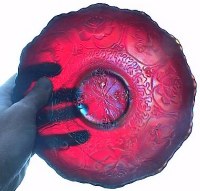 |
 |
Dragon & Lotus - Fenton - Red
|
Note the yellow on the edge points
|
Note the yellow or amber on the base
|
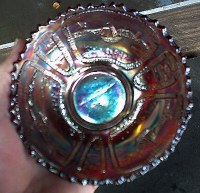 |
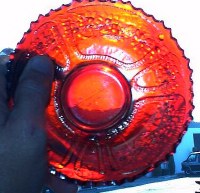 |
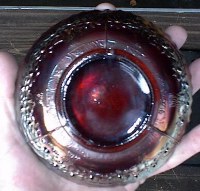 |
Sailboats - Fenton - Red
|
Cherry Red with some yellow on points
|
Cherry red base
|
Notes
The correct term for "yellow points" is Amberina.
Reverse Amberina refers to the glass condition when red is more or less
centered in the middle area of the piece, with the amberina sometimes quite
wide from edge toward center of piece.
VERY IMPORTANT NOTE HERE FOR BEGINNERS
There were no red carnival watersets made in the old carnival. NONE, ZIP, ZILCH, a big ZERO. No early maker made a red carnival waterset. You may see red carnival watersets and they are very beautiful BUT, they are 1960's or newer.
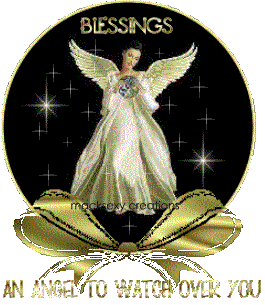
back to Carnival Glass 101
Should you care to contact the Frys, their email address is:
Search Carnival Glass 101
Our other sites you may enjoy:
Everything you EVER wanted to know about Indiana Glass
Great Reference for Newer Carnival Glass.
Complete Glassware Catalogs Available to Download
Questions? Comments? Suggestions? Broken Links? Corrections?
Your Friendly Webmaster is here to help!
back to CLICK HERE.
